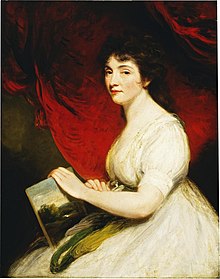Mary Linwood
Mary Linwood (born July 18, 1755 in Birmingham , † March 2, 1845 in London ) was an English artist and head of a private school, which later became known as the Mary Linwood Comprehensive School .
life and work
Linwood was the second of six children to Matthew Linwood and his wife, Hannah Turner. After the death of her father, her mother opened a private boarding school in Leicester, later the Mary Linwood Comprehensive School. After her mother passed away, she ran the school until shortly before her death. She embroidered her first picture when she was 13 years old, and her last when she was seventy-eight. For nearly seventy-five years she mimicked popular worsted embroidery paintings. In 1776 and 1778 her pictures were shown in the exhibition of the Society of Artists. In 1786 she sent examples to the Society for the Promotion of the Arts and was awarded a medal with the words “Excellent imitation of pictures in handicrafts” engraved on it. She exhibited her work across Europe, including France and Russia , where Catherine the Great offered her £ 40,000 for the entire collection. In 1808 Charles-Maurice de Talleyrand-Périgord presented her to Napoleon , whose portrait she embroidered twice. He wanted her to bring her exhibition to Paris , but this was prevented by the outbreak of war between the two countries. In 1809 she moved into a permanent gallery in Savile House in Leicester Square , the former studio of Sir Joshua Reynolds , where she arranged an exhibition of fifty-five "needle paintings" that was open until her death in 1845. Their exhibitions were the first to be gas-lit to allow viewing until late in the afternoon. During her annual visit to her exhibition in London, she contracted the flu in 1844 and died. She was buried in St. Margaret's Church in Leicester, where her parents were also buried. Their entire collection was auctioned at Christie's after both the British Museum and the House of Lords rejected their offer to donate their collection to them.
She worked with stitches of different lengths on fabrics specially made for her in Leicester. Her long and short stitches looked like brush strokes and her embroidery technique was copied by many. Her copies of old master paintings made from crewel wool (named after the crewel or worsted wool used ) have gained great fame since their first exhibition in London in 1787. Your copy of a painting by Italian artist Salvator Rosa has sold for more than the original. She was so successful that she was able to commission John Hoppner to paint her portrait. At the time he was the chief painter of the Prince of Wales (later George IV) and the most important portraitist in England. Charles Dickens mentioned them in A Plated Article, his description of a visit to Staffordshire found in Reprinted Pieces. Embroidery historians, along with Mary Knowles and Anne Eliza Morritt, list her as the most notable needle painter who inspired the practice of Berlin wool work known as needlepoint.
literature
- Hunter, Clare: Threads of life: A History of the World through the Eye of a Needle. London: Scepter (Hodder & Stoughton), 2019, ISBN 978-1473687912 .
- Butt, Stephen: The History of Leicester in 100 People , 2013, ISBN 978-1445616858 .
Web links
- Biography with Meg Andrews
- Mary Linwood (18th July 1755 - 2nd March 1845) - needlework artist
- Posts Tagged 'Mary Linwood' Mary Linwood's Exhibitions of Her Needlework, 1798-1845
| personal data | |
|---|---|
| SURNAME | Linwood, Mary |
| BRIEF DESCRIPTION | English embroiderer |
| DATE OF BIRTH | July 18, 1755 |
| PLACE OF BIRTH | Birmingham |
| DATE OF DEATH | March 2, 1845 |
| Place of death | London |

